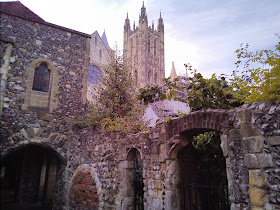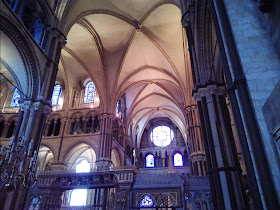There are several ways of approaching watercolour paintings
of buildings and I suppose the most reliable would be pencil then pen then
rubber then wash.
By this I mean you do a pencil sketch and by the process of
rubbing out the bits that looks wrong and putting them right you then get
something you can go over with a Pitt pen or some other permanent fine liner
pen. All you have to do then is rub out the pencil and colour the sketch in
with very diluted watercolour.
However you go about it with watercolour very thin or
diluted tends to produce the best results.
Another technique is drawing a feint pencil sketch to guide
your brush strokes, B hardness pencils or harder don’t smudge much when you get
their marks wet and once the paint is dry a lot of the pencil will rub off if
you want it to.
These are all good techniques used by important artists I
don’t think there is any such thing as cheating in art, just different
techniques –it’s the results that count.
Back in 2011 when I first started drawing and painting I
used all of the above, however recently I have been painting just with a brush
in watercolour. There is no way back in any real and useful sense with this
method, basically I paint something, looks at the mistakes and then go back and
paint it again.
You can see from the photo I still have some way
to go with this process, the cathedral is a rather demanding model, with lots
of complex shapes which really lend themselves to the rubbing out method.
I think this applies to modern buildings as well
to an extent, I had a go at painting a bit of the University of Kent from the
Gulbenkian Theatre Café yesterday. It’s fairly easy to express the look and
feel of modernish campus buildings with photographs, but watercolour is another
matter.
Personally having had a difficult time in educational
establishments I don’t necessarily feel particularly comfortable on campus. Something
like a concentration camp survivor going on holiday to Butlins is as close as I
can get. With a painting I hope to express something that wouldn’t be found in
a photograph, so I think I will need to have various attempts going back and
painting there to get this one how I want too.
On to the photographs of Canterbury, once again taken with
my new and very cheap mobile phone an OUKITEL K6000 Pro. Now with addition of A
Better Camera App, the main advantage of the app being that I can set the
phone’s camera focus on infinity. This means that in strong light everything
more than about 3 feet away is always in focus and in poorer lighting
conditions everything more than 6 feet away is in focus.
The cathedral with its difficult lighting and some
outside shots pretty much straight into the sun seemed to be a good place to
better learn a new phone camera, so here are the photos.













































No comments:
Post a Comment
Comments, since I started writing this blog in 2007 the way the internet works has changed a lot, comments and dialogue here were once viable in an open and anonymous sense. Now if you comment here I will only allow the comment if it seems to make sense and be related to what the post is about. I link the majority of my posts to the main local Facebook groups and to my Facebook account, “Michael Child” I guess the main Ramsgate Facebook group is We Love Ramsgate. For the most part the comments and dialogue related to the posts here goes on there. As for the rest of it, well this blog handles images better than Facebook, which is why I don’t post directly to my Facebook account, although if I take a lot of photos I am so lazy that I paste them directly from my camera card to my bookshop website and put a link on this blog.